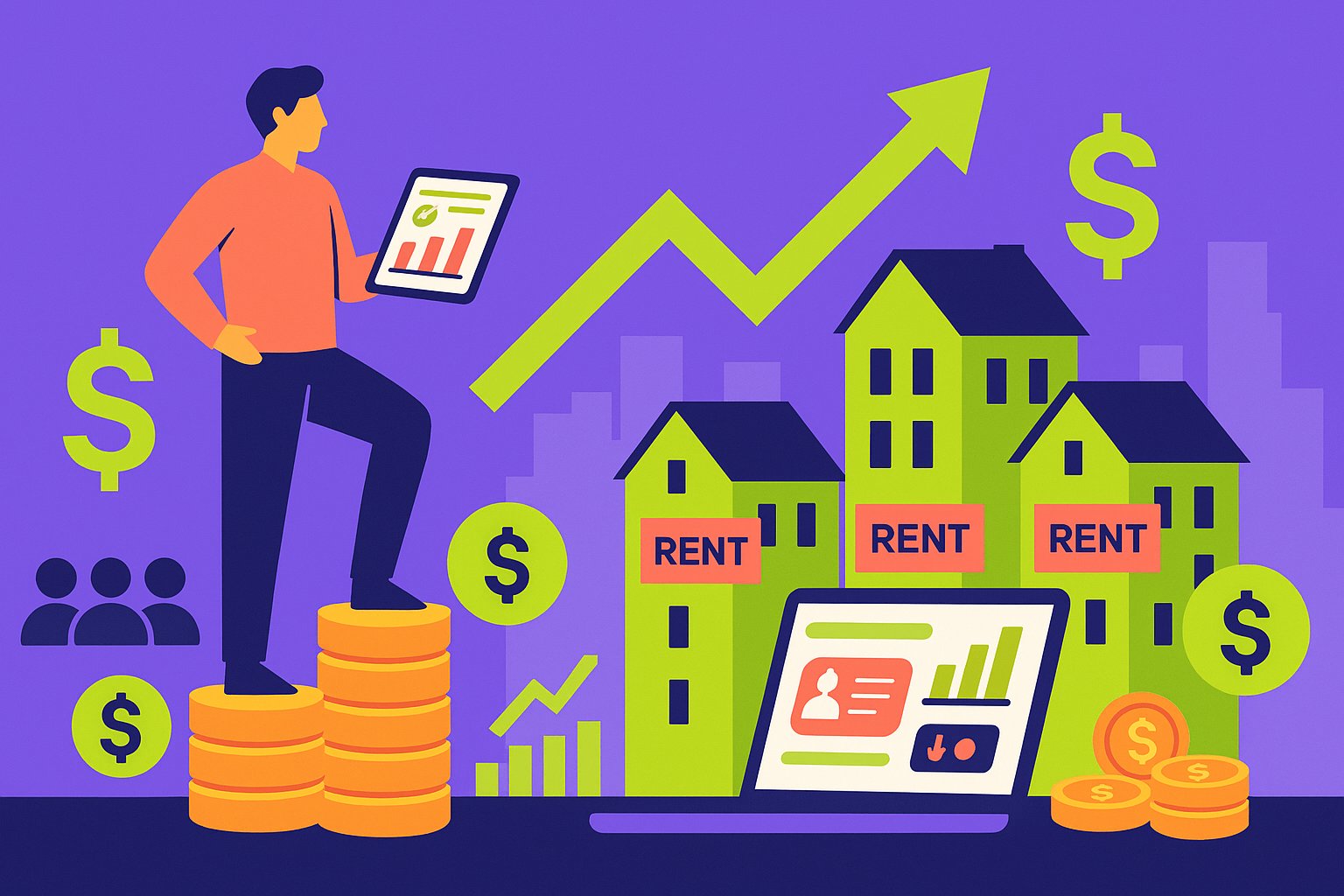Seizing New Avenues Beyond Traditional Rentals
For seasoned landlords accustomed to the grind of property management—screening tenants, handling maintenance calls, and battling vacancy cycles—the concept of expanding through real estate crowdfunding may seem revolutionary. Yet this digital frontier offers an elegant solution: scaling portfolios without the headaches of direct ownership in every asset. By tapping into professionally vetted projects alongside other investors, landlords can diversify risk, access institutional-quality deals, and generate passive income streams. In this exploration, we’ll reveal how landlords can harness real estate crowdfunding to enhance cash flow, broaden geographic exposure, and optimize tax benefits—all while preserving time and energy for core rental operations.
Translating Rental Expertise into Crowdfunded Success
Landlords already possess valuable insights into property fundamentals: neighborhood selection, tenant demographics, and local market cycles. These skills translate seamlessly into the due diligence required for crowdfunding. When evaluating a crowdfunded deal, a landlord’s experience in analyzing vacancy rates, rent comps, and local economic drivers becomes a major advantage. Instead of touring individual properties, crowdfunding platforms aggregate assets into diversified projects—such as multifamily apartment complexes, mixed-use developments, or commercial office refurbishments. Landlords can leverage their existing knowledge to assess a sponsor’s underwriting rationale, scrutinize pro forma assumptions, and validate market rent projections. By applying their rental acumen within a digital ecosystem, landlords build confidence in selecting high-potential crowdfunding offerings.
Navigating the Crowdfunding Platform Landscape
Not all real estate crowdfunding platforms are created equal. Each marketplace offers distinct investment minimums, fee structures, and asset specializations. For example, some platforms concentrate on stabilized properties with immediate cash flow, while others focus on value-add projects that require renovation before reaching full income potential. As a landlord, start by mapping your investment objectives: are you seeking steady quarterly distributions to supplement rental income, or do you prefer higher-growth equity plays that reinvest profits until a future sale? Once you clarify these goals, compare platforms based on track record, sponsor vetting processes, and transparency of financial disclosures. Review historical performance reports to gauge realized internal rates of return (IRR) and equity multiples. Platforms with decade-long track records and repeat sponsors often present lower risk profiles than newly launched marketplaces. By carefully vetting platform credibility and deal variety, landlords set a firm foundation for crowdfunding success.
Architecting a Diversified Crowdfunded Portfolio
Diversification remains the cardinal rule for any investor—and landlords are no exception. Within crowdfunding, diversification takes shape across multiple dimensions: asset class, geographic region, and risk profile. Instead of allocating a large sum into a single project, consider spreading capital across ten or more offerings. Mix equity deals—where returns derive from property appreciation and cash distributions—with debt offerings that generate fixed interest payments. For instance, pairing a core multifamily apartment complex in a stable secondary market with a value-add student housing project in a fast-growing college town balances cash flow stability against higher return potential. Landlords familiar with cyclical rental markets can also use crowdfunding to hedge against localized downturns by investing in properties across different states. This broad exposure helps smooth cash flow fluctuations, ensuring rental revenue remains complemented by reliable distributions from crowdfunded assets.
Leveraging Rental Income for Crowdfunded Acquisitions
One of the most powerful strategies for landlords is to recycle existing rental cash flows into crowdfunding investments. Rather than deploying large lump sums, consider diverting a portion of monthly net rental income—once reserves are adequately funded—toward crowdfunding contributions. By automating these transfers, you’ll steadily grow a parallel passive income stream without disrupting property operations. Some platforms allow investors to set up recurring contributions, making it simple to allocate a fixed amount each month. Over time, the compounding effect of reinvested distributions can outpace singular equity investments. This disciplined approach mirrors the concept of dollar-cost averaging, reducing the risk of mistimed market entries. As a result, even landlords with modest portfolios can accumulate substantial crowdfunded positions that bolster long-term wealth.
Conducting Rigorous Due Diligence on Syndication Deals
In the landlord world, due diligence often means verifying a tenant’s credit score or inspecting a roof for potential leaks. In crowdfunding, due diligence shifts to scrutinizing sponsor credibility, financial projections, and exit strategies. Begin by assessing the sponsor’s track record: How many projects have they completed? Did their past deals meet projected timelines and financial goals? Examine historical IRRs and cash-on-cash returns to determine reliability. Next, delve into the financial model within the offering memorandum. Compare projected rental rates against local comps sourced from platforms like CoStar or Zillow. Validate assumed operating expenses—such as management fees, taxes, and insurance—by benchmarking them against similar properties. When evaluating a value-add project, confirm that the renovation budget includes realistic contingencies to account for cost overruns. Additionally, scrutinize the exit strategy: Will the sponsor refinance to return capital, or plan a full asset sale? Understanding this clarity reduces surprises when distributions commence or the project liquidates.
Maximizing Tax Efficiency Through Crowdfunding Structures
Landlords keen on minimizing tax burdens can appreciate the pass-through benefits often embedded within crowdfunding vehicles. Most crowdfunded deals utilize entities such as LLCs or limited partnerships (LPs), which issue K-1 tax forms to investors. These pass-through structures enable depreciation deductions that offset ordinary income—often translating to lower taxable earnings in the early years of investment. Furthermore, real estate professionals can use 1031 exchanges to defer capital gains taxes when selling traditional rental properties, and subsequently deploy proceeds into crowdfunded offerings, provided the platform supports direct investment through DST (Delaware Statutory Trust) structures. This strategy allows landlords to postpone tax liabilities while maintaining exposure to commercial real estate. Before embarking on any tax planning maneuver, consult a qualified CPA or tax advisor familiar with both crowdfunding regulations and 1031 exchange requirements to ensure compliance with IRS guidelines.
Balancing Liquidity Needs with Hold Periods
One of the trade-offs landlords face when integrating real estate crowdfunding is liquidity. While publicly traded REITs offer daily price discovery and immediate liquidity, crowdfunded private deals usually lock up capital for a predetermined hold period—often ranging from three to seven years. Landlords should evaluate their cash flow reserves and emergency funding needs before committing. If unforeseen property repairs or tenant vacancies arise, it’s crucial to have liquid reserves separate from crowdfunding capital. Some platforms offer secondary markets for early exits, but pricing on these exchanges can vary significantly from initial valuations, and buyer demand may be limited. To mitigate liquidity risk, structure the portfolio with a balance of shorter-term debt offerings—where funds are repaid in one to two years—and longer-term equity plays that accumulate appreciation over time. This calibrated mix ensures that some portion of your crowdfunded capital returns sooner, providing flexibility in adjusting to evolving financial conditions.
Harnessing Technology for Continuous Monitoring
Effective portfolio management hinges on timely insights. Leading crowdfunding platforms furnish investor dashboards that track real-time distributions, occupancy rates, and cash flow statements. However, landlords accustomed to hands-on property oversight should consider consolidating data from multiple platforms into a centralized tracking system. Third-party portfolio aggregation tools can compile metrics such as net cash flow, internal rate of return, and equity multiples, offering a unified dashboard view of crowdfunded assets. By setting custom alerts for significant performance deviations—like occupancy dips or expense spikes—landlords can engage sponsors early to address issues before they snowball. Embracing these digital tools illuminates the inner workings of each investment, much like monitoring rent rolls and maintenance logs on owned properties. Staying vigilant ensures you can adapt swiftly to market shifts, sponsor updates, and macroeconomic changes that influence asset performance.
Partnering with Sponsors to Unlock Co-Investment Opportunities
As landlords cultivate trust with successful sponsors, exclusive co-investment invitations can emerge. Sponsors often reward high-performing investors—those who participate early, respond promptly, and help projects reach fundraising targets—with allocations in off-market deals or priority access to replenishment rounds. By attending sponsor-hosted webinars, in-person site visits, or annual investor summits, landlords demonstrate their commitment and gain deeper insights into future pipelines. These curated co-investment prospects typically carry more favorable economics—such as reduced fees or improved profit-sharing splits—compared to wider marketplace offerings. In the crowdfunding realm, such partnerships resemble the landlord’s practice of collaborating with established property managers or JV (joint venture) partners to secure better deal flow in competitive markets. By nurturing these relationships, landlords position themselves at the forefront of institutional-quality real estate opportunities.
Understanding Risk Mitigation and Downside Protection
Even the most meticulously underwritten crowdfunded assets carry risk. To manage downside exposure, landlords should analyze downside scenarios within offering documents—sensitivities that show how returns shift under strained assumptions, such as slower lease-up periods or higher-than-expected vacancies. Many projects include contingency reserves—funds set aside to cover unexpected cost overruns or leasing challenges. Confirm the size of these reserves relative to total project costs and inquire about sponsor contributions to backstop potential shortfalls. In senior debt offerings, landlords benefit from the comfort of first lien positions, which safeguard principal repayments even if the project underperforms. Mezzanine debt and preferred equity tranches, while offering higher yields, sit lower in the capital stack and thus bear greater risk. By carefully calibrating allocations across senior and junior positions, landlords can strike the right balance between yield and principal protection—mirroring their approach when financing or partnering on direct real estate acquisitions.
Crafting a Roadmap for Sustainable Portfolio Growth
Expanding a landlord’s portfolio through crowdfunding isn’t a one-off experiment—it demands a systematic, repeatable process that evolves with market conditions. Begin by setting clear benchmarks for performance: target a weighted average annualized return that complements your existing rental yields, while maintaining acceptable risk thresholds. Schedule quarterly portfolio reviews to reallocate capital from underperforming or fully realized deals into fresh offerings, ensuring capital remains perpetually at work. As properties change hands or refinance, reinvest distributions into new projects that align with shifting market hotspots—such as Sun Belt metropolitan areas experiencing strong population and job growth. Simultaneously, monitor macro-level indicators like interest rate trends and construction pipelines, adjusting your strategy if cap rates compress or supply-side pressures rise. By treating your crowdfunded holdings with the same analytic rigor as physical rental assets, landlords can methodically scale wealth, hedge against local market volatility, and fortify long-term financial security.
Charting the Future of Hybrid Real Estate Investing
The convergence of direct rental ownership with digital crowdfunding ushers in a hybrid investing model where landlords enjoy the best of both worlds: hands-on property cash flow and passive, scalable income streams. As technology advances, anticipate increased integration between property management software and crowdfunding dashboards, enabling landlords to oversee all real estate holdings from a single interface. Blockchain-powered tokenization could further democratize access, allowing fractional ownership of high-value trophy properties at minimal investment thresholds. In this evolving ecosystem, landlords who embrace diversification through crowdfunding gain a competitive edge: they can capitalize on emerging markets, leverage institutional-grade deal flow, and insulate themselves from localized downturns. By blending traditional land lording expertise with digital investment acumen, savvy property owners can propel their wealth-building journey to new heights—redefining what it means to be a modern real estate investor.




